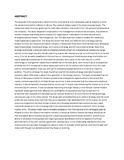| dc.contributor.author | Koigi, Hannah W | |
| dc.date.accessioned | 2013-11-21T06:37:49Z | |
| dc.date.available | 2013-11-21T06:37:49Z | |
| dc.date.issued | 2013-10 | |
| dc.identifier.citation | Master Of Business Administration (mba) Degree, School Of Business, University Of Nairobi, 2013 | en |
| dc.identifier.uri | http://erepository.uonbi.ac.ke:8080/xmlui/handle/123456789/59672 | |
| dc.description.abstract | The purpose of the study was to determine the International entry strategies used by
Huawei to enter the telecommunication industry in Kenya. The research design used in
the study was case study. The researcher used interview guides as the main data
collection instrument from the sampled employees at the company. The study targeted 5
employees in the management levels of the company. A qualitative content analysis was
employed to analyse the respondents’ views about the international entry strategies used
by Huawei Technologies Co. Ltd. The data was then coded to enable the researcher made
explanatory assertions. The study found out that there are different entry strategy used by
Huawei to enter the telecommunication industry in Kenya and these were International
entry strategies, exporting strategy, licensing strategy, joint venture strategy and full
ownership strategy. Exporting strategy is whereby a company sells its physical products
which are manufactured outside the target country to the target country though exporting
is generally viewed as a low commitment form of market entry, it is not as easily
classified on this continuum. Licensing and franchising strategy is whereby non-equity
associations between an international company and a party in the host country in which
technology or management systems are transferred to the host party. Joint venture as an
arrangement whereby the firm is required to share equity and control of the venture with
a partner from the host country and participation may vary with some companies
accepting either a minority or majority position. The other strategy the study found out
was full ownership strategy whereby the parent company takes 100% equity stake in the
operation in the foreign country.
The study concluded that the choice of Kenya as a market for Huawei products has
enlarged the opportunities in Kenya and the nearby markets especially in the East African
countries. It also concluded that the telecommunications industry in Kenya has been
characterized by a price war in recent years following the market entry of the third and
fourth network. It also concluded that being a foreign industry in the Kenyan market
Huawei has faced challenges that have affected the profitability its operations and has
forced them to streamline their operations in developing new revenue streams in an
environment of falling average revenue per user in the voice market. The study also
concluded that joint venture strategy was the most preferred as a market entry and that
they were significant risk associated with the formation of a joint venture arrangement
and that foreign market entry strategy decisions had evolved and as a result important
decisions on entry strategy had to be examined and the factors involved in firms’ foreign
market entry. The study made recommendations based on the International entry
strategies used by Huawei to enter the telecommunication industry in Kenya as follows:
Huawei Company should do all that is possible about its potential partner’s business
practices and financial condition, as well as its ability to complete the proposed and ongoing
projects; specifically outline all aspects of contract administration in the joint
venture agreement; develop early in the relationship distributions to joint venture partners
and cash management plans in order to consider which partner controls the cash and
make well thought out decisions since they keep on evolving. | en |
| dc.language.iso | en | en |
| dc.publisher | University of Nairobi, | en |
| dc.title | International entry strategies used by Huawei to enter the Telecommunications industry in Kenya | en |
| dc.type | Thesis | en |
| local.publisher | School of business, | en |


